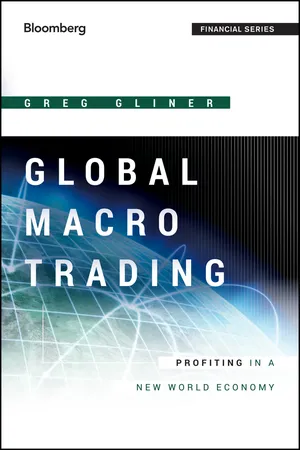
- English
- ePUB (mobile friendly)
- Available on iOS & Android
About this book
Brings global macro trading down to earth for individual and professional traders, investors and asset managers, as well being a useful reference handbook
Global Macro Trading is an indispensable guide for traders and investors who want to trade Global Macro – it provides Trading Strategies and overviews of the four asset classes in Global Macro which include equities, currencies, fixed income and commodities. Greg Gliner, who has worked for some of the largest global macro hedge funds, shares ways in which an array of global macro participants seek to capitalize on this strategy, while also serving as a useful reference tool. Whether you are a retail investor, manage your own portfolio, or a finance professional, this book equips you with the knowledge and skills you need to capitalize in global macro.
- Provides a comprehensive overview of global macro trading, which consists of portfolio construction, risk management, biases and essentials to query building
- Equips the reader with introductions and tools for each of the four asset classes; equities, currencies, fixed income and commodities
- Arms you with a range of powerful global-macro trading and investing strategies, that include introductions to discretionary and systematic macro
- Introduces the role of central banking, importance of global macroeconomic data releases and demographics, as they relate to global macro trading
Frequently asked questions
- Essential is ideal for learners and professionals who enjoy exploring a wide range of subjects. Access the Essential Library with 800,000+ trusted titles and best-sellers across business, personal growth, and the humanities. Includes unlimited reading time and Standard Read Aloud voice.
- Complete: Perfect for advanced learners and researchers needing full, unrestricted access. Unlock 1.4M+ books across hundreds of subjects, including academic and specialized titles. The Complete Plan also includes advanced features like Premium Read Aloud and Research Assistant.
Please note we cannot support devices running on iOS 13 and Android 7 or earlier. Learn more about using the app.
Information
Part One
An Overview of Global Macro
Chapter 1
Surveying the Global Macro Landscape
Types of Global Macro Strategies
Discretionary
Systematic
Table of contents
- Cover
- Contents
- Title
- Copyright
- Dedication
- Preface
- Acknowledgments
- Part One: An Overview of Global Macro
- Part Two: Global Macro Trading Foundation
- References
- About the Author
- Index
- End User License Agreement